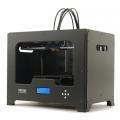Results 1 to 10 of 10
Thread: ABS surface finish results?
-
02-20-2016, 11:21 PM #1Student

- Join Date
- Feb 2016
- Posts
- 8
ABS surface finish results?
New FFCP user here - I've had my machine about two weeks. Using ABS, I did a few test prints, and made a few of the thingiverse upgrade parts - filament alignment bracket, side handle covers, table wingnut covers and spindle for small diameter filament spools. I've overcome lifting at the base plate and even a nice extruder clog. Now that I've got prints running to completion I'm wondering how I can get my surface finish more consistent. It appears that some of the lines are laid down a bit thicker, and there are what appear to be drag marks at random places across the surface, either from the extruder head or perhaps small bits of filament that stayed attached to it.
I'm printing with ABS, extruder temp 235C, bed temp at 110C and layer height of 0.25mm. I'm using Simplify3D and the tool paths look correct there. Any clues about what I should be adjusting to get this right?
Thanks, Mel
pupfinish.jpg
-
02-21-2016, 04:10 AM #2Engineer-in-Training

- Join Date
- Sep 2014
- Location
- Brummen, Netherlands
- Posts
- 265
First of all your print is nearly as good as it gets.
You will get more precise bottom layers if you lower the heatbed temperature to 95 C. That 110 C is a very persistent thing from the old days when people had difficulty in making things stick to the bed. With glass and hairspray / 3DLac there is no longer a problem.
As to the top layers, if the drag marks are from the second nozzle, then you need to adjust the height of that one a bit, which means removing the fan to get to the grub screw holding the heat throat.
As to the 'extra' plastic being laid down, you can adjust the extrusion multiplier a bit (S3D extruder tab, Advanced settings). Try 0.98, then 0.96 etc. Once you found a good value, try upping it by 0.01 again. Beware that it is interdependent with the extrusion speed, so if you change the printing speed, you may need to change the extrusion multiplier as well.
-
02-21-2016, 12:14 PM #3Student

- Join Date
- Feb 2016
- Posts
- 8
Thanks Alibert, I'll give that a try.
-
02-21-2016, 12:35 PM #4
Lots of room for improvement. Do the following:
1) Calibrate your extrude. Read the sailfish guide in the Flashforge forum.
2) bed temp 95° - 100°
3) extruder temp 220° - 240°
4) enclose and preheat your printer
-
02-21-2016, 07:02 PM #5
Looks pretty good overall, but yes there is some room for improvement. CHeck out these two guides to help you resolve finish issues you'll run into.
https://www.simplify3d.com/support/p...oubleshooting/
http://support.3dverkstan.se/article...shooting-guide
-
02-21-2016, 07:44 PM #6
That won't give them more uniform base layers unfortunately.
Level your bed again, and then again, and then again one more time after that. If you are getting inconsistent initial layers there is only generally 3 causes.
1. Filament slipping and not extruding properly, increase or decrease filament width (ie instead of 1.75 try 1.76)
2. Clogged nozzle not allowing even extrusion.
3. Bed not perfectly level.
There are a few good bed levelling objects you can try, saves you alot of time and headaches
example:
http://www.thingiverse.com/thing:215386Hex3D - 3D Printing and Design http://www.hex3d.com
-
02-21-2016, 11:00 PM #7Student

- Join Date
- Feb 2016
- Posts
- 8
Thank you everyone, looks like a lot of great advice. I'll report on my progress.
-
02-22-2016, 12:06 AM #8
It's a problem that can re-occur, so don't be discouraged if it takes you some time to perfect. My flashforge did this in the beginning, and ironically enough LAST NIGHT lol ... about to set up a big print and bam.. stringy layers, then thick ones, then thin ones...
Turns out my Extruder motor has finally died!! (I always use the left extruder, no reason, just got used to it) so it's done over 3100 hours now. The stepper motor works, but it's movement is inconsistent.
When you load filament and it squirts it out the nozzle, it should be falling into a nice even circle, the sort of circle that if you let it print long enough you will end up with a slinky when you pull it out of the machine.
I noticed I was not making slinkys. It was making thick then thin slinky's.. so I felt the filament and with my fingers felt the pull of the motor, I could feel it was not feeding well, so I swapped out the motor and bam, back to brand new again. I only wish they used standard Nema17 motors, as the ones Flashforge use are slightly smaller (3.2cm instead of 4cm deep) so the standard Nema starts interfering with endstop locations because the motor bangs against the frame due to it being oversize.Hex3D - 3D Printing and Design http://www.hex3d.com
-
02-22-2016, 12:37 AM #9Student

- Join Date
- Feb 2016
- Posts
- 8
Thanks Geoff, and sorry my question caused extruder contagion! Seriously, 3100 hours is a lot of print time - nice to know these machines can handle serious work loads.
I've re-leveled the bed and reduced the extruder temp to 220C, and I'm printing the "test left.x3g" file that was on the SD card that came with my printer. If this looks good, I'll run the Sailfish calibration. I also suspect that a bit of vertical retraction will help.
I really appreciate all the advice.
-
03-03-2016, 11:37 PM #10Student

- Join Date
- Feb 2016
- Posts
- 8
Update - been a fun week of trial and error. Last weekend I made some unintended art:
goop.jpg
So much for leaving a print unattended overnight! Cleaning up this mess required dismantling the extruder assembly, soaking the hot ends in acetone and reconnecting the right side thermocouple. I took the opportunity to level the hot ends, using a combination of Geoff's set screw technique and fine tuning with aluminum foil shims. Not perfect but much better than it was.
With that accomplished I took a big step and started using HIPS for raft and support. Confirmed the dual extruders work with the traffic cone model and ran another model:
PupUp.jpg
Better than before, but still with the uneven finish across the top. Finally I flipped the models over in S3d and that made all difference:
PupDown2.jpg
Oddly, the prints are coming out a little bit small (~1%) but only in the X direction, not Y or Z. I would have thought that ABS shrinkage would at least happen in by X and Y.
Also, I got huge quality improvements by slowing down the print speed. S3d had the default print speed at 3600 mm/min. I slowed it down to 1200 mm/min. Obviously much longer to print, but no point printing lousy parts quickly.
Anyway, big steps and I wanted to share for anyone else who might find it useful.Last edited by MWaldorf; 03-03-2016 at 11:44 PM.




 Reply With Quote
Reply With Quote








Extruder not feeding during print,...
04-28-2024, 02:02 PM in Tips, Tricks and Tech Help